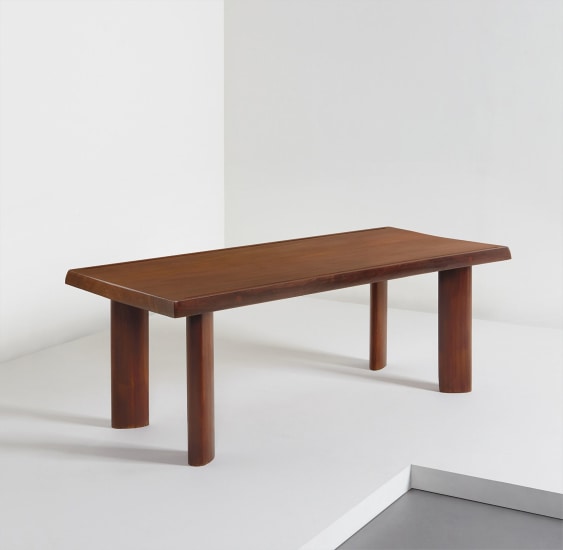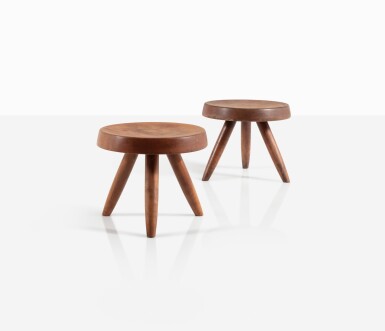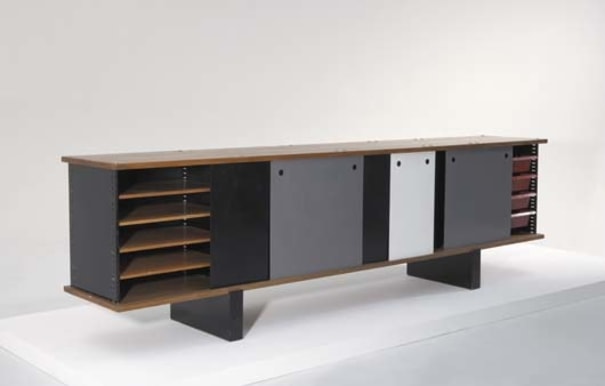Property from a Private French Collection Charlotte Perriand Follow 'Brazza' partitioned cupboard, designed for the Unité d'habitation Air France, Brazzaville circa 1952 Painted 'diamond-point' aluminium, painted aluminium, teak. 294.6 x 569 x 63.5 cm (116 x 224 x 25 in.) Manufactured by Les Ateliers Jean Prouvé France.
Provenance Unité d'habitation Air France, Brazzaville, Republic of the Congo, circa 1952 Galerie 54, Paris Acquired from the above by the present owner Literature L’architecture d’aujourd’hui , no. 40, April 1952, p. 64 for an advertisement of a similar example from the series Mary McLeod ed., Charlotte Perriand An Art of Living , New York, 2003, p. 139 Jacques Barsac, Charlotte Perriand Un art d’habiter 1903-1959 , Paris, 2005, pp. 325, 329-30 Jacques Barsac, Charlotte Perriand Complete Works Volume 2, 1940-1955 , Paris, 2015, pp. 321-23 Catalogue Essay Charlotte Perriand - 'Placards Brazza' In 1950 Charlotte Perriand began designing the interiors and furnishing designs for the Unité d'habitation Air France in Brazzaville, Republic of the Congo. The four-story building, designed by the architects Jean Hébrard, R. Lefebvre, Jean Létu and François Bienvenu, comprised sixty apartments of varied types to house Air France employees in Brazzaville, a then central connection point for flights within Africa. The building’s facade, open-plan interiors with through apartments that ran north to south, and rooftop terrace made reference to the modernist principles of Le Corbusier, and were adapted to the city’s tropical climate. Built in the centre of the park, the building featured a long facade with concrete brise-soleil that framed pivoting aluminium louvers and ventilated staircases, embracing its surrounding whilst responding to the high humidity and temperature. Painted reddish ochre – a complementary colour to the surrounding lush landscape – the brise-soleil emphasised the grid-like composition of the facade punctuated by the white mashrabiyas of the building’s staircases. Perriand studied the building’s exterior colour scheme, which, heightened by the facade’s horizontal and vertical lines, provided a rhythmic structuring that Perriand extended into the interior of the building. Fundamental to Perriand’s interiors for the Unité d'habitation Air France were her designs for storage units or cupboards, known as ‘Placards Brazza’. She designed eight standardised models that could be combined based on their placement and use within each apartment. The cupboards were built into ‘hollow corpuses’ in the concrete walls of the apartment kitchens, living rooms, and bedrooms. For Perriand these designs were ‘…all the more critical as the habitable space decreased and one can say that the built-in storage ‘volume’ has to increase as a function of the decrease in vital space’ (Charlotte Perriand ‘Le problème du rangement’, L’architecture d’aujourd’hui , no. 56, October 1954, p. 51). Perriand developed the floor-to-ceiling cupboard model she had designed for the kitchen of Élisabeth de Vilmorin, Paris (1949-50) and the sliding door system she had used in her designs for the Unité d'Habitation, Marseille (1947-49), for which she had been granted the patent for its sliding element. Perriand sought to put the cupboards into mass production, making the designs available to the public. In 1951 she presented her studies to Jean Prouvé who offered to undertake the production of the cupboards’ folded sheet metal frames. The project marked Perriand’s first large-scale collaboration with the Ateliers Jean Prouvé whose furniture with her own modifications she used to furnish the apartments. For the cupboard doors, which were produced in several colours as illustrated by the present lot, Perriand used diamond-point sheet metal manufactured by Cegedur Company, Paris. Later that year in a letter to Prouvé, Perriand wrote, ‘To start, I am very happy about the 'Brazza' prototype. I believe that this time we’ve gotten it right and that these facades fulfill the desires of a large number of architects: elimination of awkward constraints, combination of traditional architecture and factory-built facades easy to include in a plan, rapid mounting, a luxury finish for a modest price, installation with ventilation for tropical countries, [and] unventilated in
Property from a Private French Collection Charlotte Perriand Follow 'Brazza' partitioned cupboard, designed for the Unité d'habitation Air France, Brazzaville circa 1952 Painted 'diamond-point' aluminium, painted aluminium, teak. 294.6 x 569 x 63.5 cm (116 x 224 x 25 in.) Manufactured by Les Ateliers Jean Prouvé France.
Provenance Unité d'habitation Air France, Brazzaville, Republic of the Congo, circa 1952 Galerie 54, Paris Acquired from the above by the present owner Literature L’architecture d’aujourd’hui , no. 40, April 1952, p. 64 for an advertisement of a similar example from the series Mary McLeod ed., Charlotte Perriand An Art of Living , New York, 2003, p. 139 Jacques Barsac, Charlotte Perriand Un art d’habiter 1903-1959 , Paris, 2005, pp. 325, 329-30 Jacques Barsac, Charlotte Perriand Complete Works Volume 2, 1940-1955 , Paris, 2015, pp. 321-23 Catalogue Essay Charlotte Perriand - 'Placards Brazza' In 1950 Charlotte Perriand began designing the interiors and furnishing designs for the Unité d'habitation Air France in Brazzaville, Republic of the Congo. The four-story building, designed by the architects Jean Hébrard, R. Lefebvre, Jean Létu and François Bienvenu, comprised sixty apartments of varied types to house Air France employees in Brazzaville, a then central connection point for flights within Africa. The building’s facade, open-plan interiors with through apartments that ran north to south, and rooftop terrace made reference to the modernist principles of Le Corbusier, and were adapted to the city’s tropical climate. Built in the centre of the park, the building featured a long facade with concrete brise-soleil that framed pivoting aluminium louvers and ventilated staircases, embracing its surrounding whilst responding to the high humidity and temperature. Painted reddish ochre – a complementary colour to the surrounding lush landscape – the brise-soleil emphasised the grid-like composition of the facade punctuated by the white mashrabiyas of the building’s staircases. Perriand studied the building’s exterior colour scheme, which, heightened by the facade’s horizontal and vertical lines, provided a rhythmic structuring that Perriand extended into the interior of the building. Fundamental to Perriand’s interiors for the Unité d'habitation Air France were her designs for storage units or cupboards, known as ‘Placards Brazza’. She designed eight standardised models that could be combined based on their placement and use within each apartment. The cupboards were built into ‘hollow corpuses’ in the concrete walls of the apartment kitchens, living rooms, and bedrooms. For Perriand these designs were ‘…all the more critical as the habitable space decreased and one can say that the built-in storage ‘volume’ has to increase as a function of the decrease in vital space’ (Charlotte Perriand ‘Le problème du rangement’, L’architecture d’aujourd’hui , no. 56, October 1954, p. 51). Perriand developed the floor-to-ceiling cupboard model she had designed for the kitchen of Élisabeth de Vilmorin, Paris (1949-50) and the sliding door system she had used in her designs for the Unité d'Habitation, Marseille (1947-49), for which she had been granted the patent for its sliding element. Perriand sought to put the cupboards into mass production, making the designs available to the public. In 1951 she presented her studies to Jean Prouvé who offered to undertake the production of the cupboards’ folded sheet metal frames. The project marked Perriand’s first large-scale collaboration with the Ateliers Jean Prouvé whose furniture with her own modifications she used to furnish the apartments. For the cupboard doors, which were produced in several colours as illustrated by the present lot, Perriand used diamond-point sheet metal manufactured by Cegedur Company, Paris. Later that year in a letter to Prouvé, Perriand wrote, ‘To start, I am very happy about the 'Brazza' prototype. I believe that this time we’ve gotten it right and that these facades fulfill the desires of a large number of architects: elimination of awkward constraints, combination of traditional architecture and factory-built facades easy to include in a plan, rapid mounting, a luxury finish for a modest price, installation with ventilation for tropical countries, [and] unventilated in


.jpg)


.jpg)

.jpg)
.jpg)
.jpg)
.jpg)
.jpg)


Testen Sie LotSearch und seine Premium-Features 7 Tage - ohne Kosten!
Lassen Sie sich automatisch über neue Objekte in kommenden Auktionen benachrichtigen.
Suchauftrag anlegen